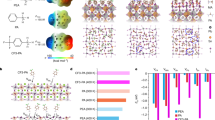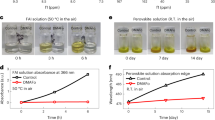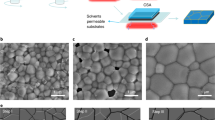Abstract
Doping of perovskite semiconductors1 and passivation of their grain boundaries2 remain challenging but essential for advancing high-efficiency perovskite solar cells. Particularly, it is crucial to build perovskite/indium tin oxide (ITO) Schottky contact based inverted devices without predepositing a layer of hole-transport material3,4,5. Here we report a dimethylacridine-based molecular doping process used to construct a well-matched p-perovskite/ITO contact, along with all-round passivation of grain boundaries, achieving a certified power conversion efficiency (PCE) of 25.39%. The molecules are shown to be extruded from the precursor solution to the grain boundaries and the bottom of the film surface in the chlorobenzene-quenched crystallization process, which we call a molecule-extrusion process. The core coordination complex between the deprotonated phosphonic acid group of the molecule and lead polyiodide of perovskite is responsible for both mechanical absorption and electronic charge transfer, and leads to p-type doping of the perovskite film. We created an efficient device with a PCE of 25.86% (reverse scan) and that maintained 96.6% of initial PCE after 1,000 h of light soaking.
This is a preview of subscription content, access via your institution
Access options
Access Nature and 54 other Nature Portfolio journals
Get Nature+, our best-value online-access subscription
$29.99 / 30 days
cancel any time
Subscribe to this journal
Receive 51 print issues and online access
$199.00 per year
only $3.90 per issue
Buy this article
- Purchase on Springer Link
- Instant access to full article PDF
Prices may be subject to local taxes which are calculated during checkout





Similar content being viewed by others
Data availability
All data are available in either the main text or supplementary materials, and are also available from the corresponding author on reasonable request.
References
Euvrard, J., Yan, Y. & Mitzi, D. B. Electrical doping in halide perovskites. Nat. Rev. Mater. 6, 531–549 (2021).
Aydin, E., Bastiani, M. D. & Wolf, S. D. Defect and contact passivation for perovskite solar cells. Adv. Mater. 31, 1900428 (2019).
Wu, W. Q. et al. Molecular doping enabled scalable blading of efficient hole-transport-layer-free perovskite solar cells. Nat. Commun. 9, 1625 (2018).
Prasanna, R. et al. Design of low bandgap tin–lead halide perovskite solar cells to achieve thermal, atmospheric and operational stability. Nat. Energy 4, 939–947 (2019).
Ye, S. et al. A breakthrough efficiency of 19.9% obtained in inverted perovskite solar cells by using an efficient trap state passivator Cu(thiourea)I. J. Am. Chem. Soc. 139, 7504–7512 (2017).
Zhao, Y. et al. Inactive (PbI2)2 RbCl stabilizes perovskite films for efficient solar cells. Science 377, 531–534 (2022).
Jiang, Q. et al. Surface reaction for efficient and stable inverted perovskite solar cells. Nature 611, 278–283 (2022).
Best research-cell efficiencies chart. National Renewable Energy Laboratory https://www.nrel.gov/pv/assets/pdfs/best-research-cell-efficiencies.pdf (2023).
Rombach, F. M., Haque, S. A. & Macdonald, T. J. Lessons learned from spiro-OMeTAD and PTAA in perovskite solar cells. Energy Environ. Sci. 14, 5161–5190 (2021).
Cameron, J. & Skabara, P. J. The damaging effects of the acidity in PEDOT:PSS on semiconductor device performance and solutions based on non-acidic alternatives. Mater. Horiz. 7, 1759–1772 (2020).
Sendner, M., Trollmann, J. & Pucci, A. Dielectric function and degradation process of poly(triarylamine) (PTAA). Org. Electron. 15, 2959–2963 (2014).
Boyd, C. C. et al. Overcoming redox reactions at perovskite-nickel oxide interfaces to boost voltages in perovskite solar cells. Joule 4, 1759–1775 (2020).
Ye, S. et al. A strategy to simplify the preparation process of perovskite solar cells by co-deposition of a hole-conductor and a perovskite layer. Adv. Mater. 28, 9648–9654 (2016).
Yang, W. S. et al. Iodide management in formamidinium-lead-halide-based perovskite layers for efficient solar cells. Science 356, 1376–1379 (2017).
Buin, A. et al. Materials processing routes to trap-free halide perovskites. Nano Lett. 14, 6281–6286 (2014).
Al-Ashouri, A. et al. Monolithic perovskite/silicon tandem solar cell with >29% efficiency by enhanced hole extraction. Science 370, 1300–1309 (2020).
Al-Ashouri, A. et al. Conformal monolayer contacts with lossless interfaces for perovskite single junction and monolithic tandem solar cells. Energy Environ. Sci. 12, 3356–3369 (2019).
Ullah, A. et al. Novel phenothiazine-based self-assembled monolayer as a hole selective contact for highly efficient and stable p-i-n perovskite solar cells. Adv. Energy Mater. 12, 2103175 (2021).
Chen, W. et al. Alkali chlorides for the suppression of the interfacial recombination in inverted planar perovskite solar cells. Adv. Energy Mater. 9, 1803872 (2019).
Chen, S. et al. Crystallization in one-step solution deposition of perovskite films: upward or downward? Sci. Adv. 7, eabb2412 (2021).
Chen, S. et al. Stabilizing perovskite-substrate interfaces for high-performance perovskite modules. Science 373, 902–907 (2021).
Noel, N. K. et al. Unveiling the influence of pH on the crystallization of hybrid perovskites, delivering low voltage loss photovoltaics. Joule 1, 328–343 (2017).
Li, X. et al. Improved performance and stability of perovskite solar cells by crystal crosslinking with alkylphosphonic acid omega-ammonium chlorides. Nat. Chem. 7, 703–711 (2015).
Ma, D. et al. Distribution control enables efficient reduced-dimensional perovskite LEDs. Nature 599, 594–598 (2021).
Perdew, J. P., Burke, K. & Ernzerhof, M. Generalized gradient approximation made simple. Phys. Rev. Lett. 77, 3865 (1996).
Kresse, G. & Furthmüller, J. Efficient iterative schemes for ab initio total-energy calculations using a plane-wave basis set. Phys. Rev. B Condens. Matter 54, 11169 (1996).
Naumkin, A. V. et al. NIST XPS Database (2012); https://srdata.nist.gov/xps/ElmSpectralSrch.aspx?selEnergy=PE
Jiao, H. et al. Perovskite grain wrapping by converting interfaces and grain boundaries into robust and water-insoluble low-dimensional perovskites. Sci. Adv. 8, eabq4524 (2022).
Zhang, F. & Zhu, K. Additive engineering for efficient and stable perovskite solar cells. Adv. Energy Mater. 10, 1902579 (2019).
Chen, W. et al. Molecule-doped nickel xoide: verified charge transfer and planar inverted mixed cation perovskite solar cell. Adv. Mater. 30, 1800515 (2018).
Jacobs, I. E. & Moule, A. J. Controlling molecular doping in organic semiconductors. Adv. Mater. 29, 1703063 (2017).
Scaccabarozzi, A. D. et al. Doping approaches for organic semiconductors. Chem. Rev. 122, 4420–4492 (2022).
Sze, S. M. & Ng, K. K. Physics of Semiconductor Devices (Wiley-VCH, 2006).
Scheer, R. & Schock, H.-W. Chalcogenide Photovoltaics (Wiley-VCH, 2011).
Lang, D. V. Deep‐level transient spectroscopy: a new method to characterize traps in semiconductors. J. Appl. Phys. 45, 3023–3032 (1974).
Wen, X. et al. Vapor transport deposition of antimony selenide thin film solar cells with 7.6% efficiency. Nat. Commun. 9, 2179 (2018).
Grimme, S., Antony, J., Ehrlich, S. & Krieg, H. A consistent and accurate ab initio parametrization of density functional dispersion correction (DFT-D) for the 94 elements H-Pu. J. Chem. Phys. 132, 154104 (2010).
Acknowledgements
We thank W. Tian and S. Jin from the Dalian Institute of Chemical Physics (Chinese Academy of Sciences) for transient absorption testing and data analysis, H. He from the Department of Physics (SUSTech) for discussions on semiconductor physics and W. Lu and L. Chung from the Department of Chemistry (SUSTech) for discussions on coordination chemistry. The authors thank Core Research Facilities, Department of Materials Science and Engineering for characterizations, and the Center of Computational Science and Engineering of SUSTech for calculations. We also thank the National Natural Science Foundation of China (nos. U2001216 and 52273266), the Shenzhen Key Laboratory Project (no. ZDSYS201602261933302), the Guangdong Provincial Key Laboratory of Computational Science and Material Design (grant no. 2019B030301001) and the Shenzhen Science and Technology Innovation Committee (no. JCYJ20200109141412308).
Author information
Authors and Affiliations
Contributions
Z.H., Q.T. and Z.L. conceived the idea for the project. Z.H. directed and supervised the project. Q.T. fabricated and characterized the devices. Z.L. designed and synthesized molecules and carried out NMR and FTIR characterization. G.L. performed DFT calculations. X.Z. conducted AFM-IR characterization. B.C. and T.C. carried out DLTS measurements and data analysis. G.C. and H.Y. performed UPS characterization. H.G. conducted SEM and energy-dispersive X-ray spectroscopy. G.M. conducted Hall testing. D.H. performed pH and other electrochemical testing. J.W. and J.X. participated in characterization of other properties. Z.H., Z.L. and Q.T. analysed all data and wrote the manuscript. All authors discussed the results and commented on the manuscript.
Corresponding author
Ethics declarations
Competing interests
A Chinese patent application (no. 2023100349666), submitted by SUSTech, covers the AcPA series molecule-based molecule-extrusion process for the fabrication of HTL-free perovskite solar cells.
Peer review
Peer review information
Nature thanks Xiaoming Wang, Masatoshi Yanagida and the other, anonymous, reviewer(s) for their contribution to the peer review of this work. Peer reviewer reports are available.
Additional information
Publisher’s note Springer Nature remains neutral with regard to jurisdictional claims in published maps and institutional affiliations.
Supplementary information
Supplementary Information
This Supplementary Information file contains detailed Supplementary Methods, Text, Figs. 1–38 and Tables 1–8.
Rights and permissions
Springer Nature or its licensor (e.g. a society or other partner) holds exclusive rights to this article under a publishing agreement with the author(s) or other rightsholder(s); author self-archiving of the accepted manuscript version of this article is solely governed by the terms of such publishing agreement and applicable law.
About this article
Cite this article
Tan, Q., Li, Z., Luo, G. et al. Inverted perovskite solar cells using dimethylacridine-based dopants. Nature 620, 545–551 (2023). https://doi.org/10.1038/s41586-023-06207-0
Received:
Accepted:
Published:
Issue Date:
DOI: https://doi.org/10.1038/s41586-023-06207-0
This article is cited by
-
Inhibition of halide oxidation and deprotonation of organic cations with dimethylammonium formate for air-processed p–i–n perovskite solar cells
Nature Energy (2024)
-
Multifunctional ytterbium oxide buffer for perovskite solar cells
Nature (2024)
-
Inhibition of defect-induced α-to-δ phase transition for efficient and stable formamidinium perovskite solar cells
Nature Communications (2023)
-
Hole transport layer-free inverted perovskite solar cells with power conversion efficiency exceeding 25% and much improved stability
Science China Materials (2023)
Comments
By submitting a comment you agree to abide by our Terms and Community Guidelines. If you find something abusive or that does not comply with our terms or guidelines please flag it as inappropriate.



